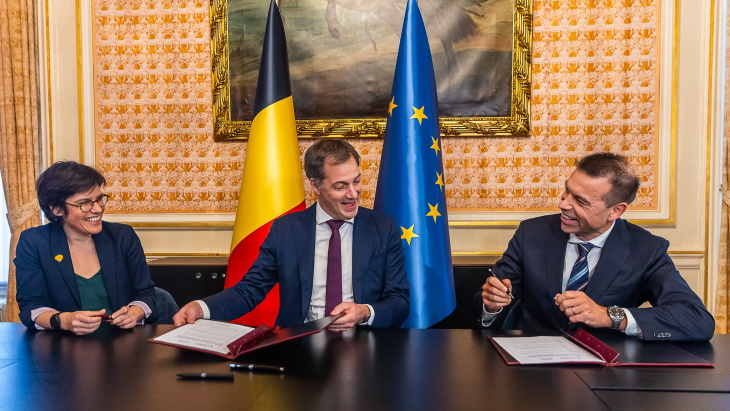Final accord reached on Belgian reactor operations
A final agreement has been signed between the Belgian government and French utility Engie to extend the operation of the Tihange 3 and Doel 4 nuclear power reactors by 10 years and on all obligations related to radioactive waste.

The signing of the agreement by, from left, Energy Minister Tinne Van der Straeten, Prime Minister Alexander De Croo and Electrabel CEO Thierry Saegeman (Image: @alexanderdecroo)
Under a plan announced by Belgium's coalition government in December 2021, Doel 3 was shut down in September 2022, while Tihange 2 shut down at the end of January this year. The newer Doel 4 and Tihange 3 would be shut down by 2025. However, in March last year the Belgian government decided to start talks with Electrabel - the Belgian subsidiary of Engie - with a view to extending the operation of Doel 4 and Tihange 3, allowing for the retention of 2 GWe of nuclear generation capacity.
In July 2022, the government and Electrabel signed a non-binding Letter of Intent on continuing negotiations on the feasibility and terms for the operation of the reactors for a further 10 years. On 9 January this year, a non-binding agreement in principle was signed that "concretised the elements" of the Letter of Intent signed in July. This was followed by an interim agreement that built on the 9 January agreement and defined the terms for the extended operation of the two reactors. A framework agreement was signed on 21 July for the continuation of negotiations with a view to reaching a final and legally binding agreement in October.
A final agreement has now been signed which confirms and endorses the key principles of the framework agreement signed on 21 July.
Specifically, the agreement confirms the commitment by both parties to implement Flexible Long-Term Operation (Flex LTO), with an estimated investment of EUR1.6-2.0 billion (USD1.7-2.2 billion), and to use their best efforts to restart the reactors as early as November 2025. It also establishes a legal structure dedicated to the two extended units, owned equally by the Belgian State and Engie.
It also confirms that the business model for the extension will have a balanced risk allocation, in particular through a Contract for Difference mechanism covering remuneration for electricity generation. The strike price is to be based on the actual cost of extending operation of the nuclear units. This cost is not yet known, but will be estimated based on the nuclear safety requirements set out by the Federal Agency for Nuclear Control. An initial price will be set in 2025 and updated in 2028 to reflect the known final cost of the extension, to cover the period up to 2035.
In addition, it determines a fixed amount to cover the future costs related to the treatment of nuclear waste, concerning all Engie nuclear facilities in Belgium, for a total of EUR15 billion payable in two instalments depending on the category of waste.
The final text also sets out the technical and operational conditions for restarting the two units from November 2025, with full guarantees of nuclear safety.
Engie said the operation of these two reactors and the dismantling work under way of its other units "will maintain around 4000 jobs (direct, indirect and induced) and will require the recruitment of 200 additional employees in the coming months".
It noted that the agreement remains subject to approval by the European Commission - with consultation currently under way - and "to the substantive vote on the legislative amendments".
"We are very pleased to announce the final signature of this agreement, which allows a balanced sharing of risks associated with the extended operation of the two nuclear units and eliminates uncertainties for Engie Group related to the evolution of nuclear waste liabilities," said Engie CEO Catherine MacGregor. "Our teams are working hard on implementing the LTOs as quickly as possible, to strengthen security of electricity supply in Belgium."
Researched and written by World Nuclear News
- China Institute of Atomic Energy
- Nuclear Power Institute of China
- Southwestern Institute of Physics
- China Nuclear Power Operation Technology Corporation, Ltd.
- China Nuclear Power Engineering Co., Ltd.
- China Institute for Radiation Protection
- Beijing Research Institute of Uranium Geology (BRIUG)
- China Institute of Nuclear Industry Strategy (CINIS)
- China Nuclear Mining Science and Technology Corporation


